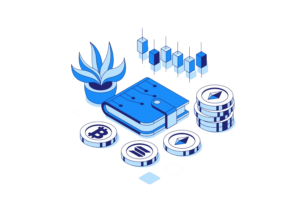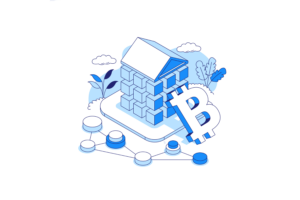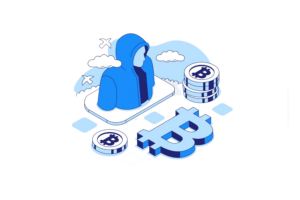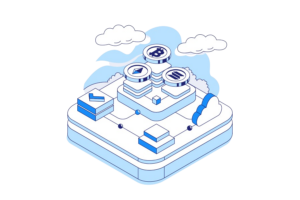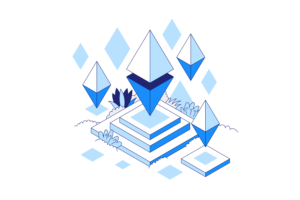Key Takeaways
- Chainlink is a decentralized oracle network that provides secure, reliable, and verifiable data to smart contracts on the blockchain.
- The LINK token is the native cryptocurrency of Chainlink
- Node operators earn LINK for providing services
- LINK also serves as an economic incentive mechanism for developers building applications within its ecosystem.
- Chainlink was first conceptualized in 2017 as a way to enable smart contracts on the blockchain securely access real-world data sources such as off-chain payments and web APIs.
- It works by connecting external resources with blockchain applications through independent intermediaries called oracles that feed real-world information into a language both parties can understand.
- Chainlink’s ICO raised $32 million
What is Chainlink?
By connecting real-world data with blockchain applications, Chainlink enables smart contracts to access external resources such as off-chain payments, web APIs, enterprise systems, and other blockchains. In this way, it facilitates more accurate and efficient execution of complex operations within a single platform. As an added benefit of its decentralization model, Chainlink also offers protection from potential manipulation by malicious actors who may attempt to interfere with transaction processing or tamper with results.
In short, Chainlink allows for increased trust in all forms of digital transactions – both on-chain transactions and off-chain transactions – while providing enhanced security for users on the blockchain.
In 2021, a whitepaper called Chainlink 2.0 was published, outlining ways for the platform to grow and evolve. Experts say Chainlink is well-positioned to accelerate the adoption of next-generation blockchain use across industries from finance to supply chains.
What is LINK?
The LINK token is the native cryptocurrency of the Chainlink network and plays a critical role in facilitating on-chain transactions as well as off-chain transactions. It provides users with access to reliable data from oracles on the Chainlink network and incentivizes node operators for providing services that facilitate these transactions. The LINK token also serves as an economic incentive mechanism for developers to build applications within the ecosystem, allowing them to receive fees for their solutions. As such, it acts as an essential bridge between real-world information and smart contracts on the blockchain, enabling the efficient execution of complex operations across platforms.
LINK is an ERC-667 token, it runs on Ethereum with similarities to the ERC-20 token. LINK isn’t designed to be used as a currency for everyday purchases, its purpose is to incentivize Chainlink operators who transfer data to and from blockchains. With its value increasing steadily since its launch in 2017, many experts believe that LINK has great potential to drive continued adoption of next-generation blockchain technology across various industries.
What is the history of Chainlink?
Chainlink is a decentralized oracle network that has been around since the early days of blockchain technology. It was first conceptualized in 2017 as a way to allow smart contracts on the blockchain to securely access real-world data and resources, such as off-chain payments and web APIs. Since its inception, Chainlink has become one of the most popular platforms for connecting on-chain transactions (transactions occurring within the blockchain) with off-chain transactions (transactions outside of the blockchain). This allows developers to build more complex applications than ever before, allowing them to access external resources such as enterprise systems and other blockchains.
An initial coin offering for Chainlink brought in the equivalent of $32 million by selling 35% of the one billion unit supply of LINK tokens. Another 35% of LINK tokens was earmarked to incentivize node operators, while the remaining 30% was used to develop the Chainlink blockchain.
How does Bitcoin work?
Chainlink is a type of platform known as a decentralized oracle network, which acts as an important link between on-chain smart contracts and external data sources. On-chain transactions refer to transactions that take place on the blockchain, while off-chain transactions are those taking place outside of it. Chainlink bridges the gap between these two types of transactions by connecting them through independent intermediaries called oracles. These oracles act as a bridge between external data (off-chain transactions) and blockchain smart contracts, allowing real-world information to be fed into the blockchain in a language that works for both parties. The decentralized nature of Chainlink’s oracle network also ensures that no single person or group has control over the data, increasing security levels and eliminating any chance for a single point of failure.
Checklist for understanding Chainlink:
- Understanding how Chainlink works means understanding smart contracts.
- Smart contracts are agreements on a blockchain that execute when a set of pre-specified conditions is met. The blockchain infrastructure ensures that these agreements are transparent and verifiable. They are also immutable, which means they can’t be changed, ensuring a high level of trust and security.
- Crowdfunding is often used as an example to explain how this concept works. If a specified amount of money is deposited into a smart contract by a specified date, the payment is released to the fundraiser. If the conditions of the smart contract are not met, the funds are returned to those who made donations.
- Smart contracts are often used to create new crypto financial products and assets. However, a key challenge is that smart contracts rely on external data sources to execute their terms.
- Chainlink solves this problem by using oracles to act as intermediaries between blockchain smart contracts and external data.
- The decentralized network of oracles is made up of nodes – node operators retrieve data from off-chain sources.
- Operators are able to set their own fee based on demand for their service and receive a reputation score, which means they can be selected based on their past performance. Operators have to stake their LINK tokens and those with the biggest stakes are in the best position to earn rewards.
- There are three steps to the process:
a) First, is oracle selection. Chainlink uses software to match up the data that is needed, with oracles that can provide it.
b) The next step is data reporting. Oracles get the needed external data and provide it to the smart contracts running on the Chainlink blockchain. c) The final step is the aggregation of the results. The validity of the data is assessed and a score is given. - To prevent oracle failure, the Chainlink white paper explains that there are three key principles:
a) Distribution of data sources
b) Distribution of oracles
c) Use of trusted hardware
Is Bitcoin safe?
Bitcoin offers unprecedented, decentralized financial security and freedom. It is powered by distributed ledger technology, so transactions are protected by advanced cryptography. This means that the Bitcoin Network getting hacked is nigh on impossible. Plus, no central authority has any control over its value or the cryptocurrency wallet in which the Bitcoin is stored. In other words; you’re in charge!
Is Chainlink a good investment?
Distributed ledger technology has revolutionized our society. When investing your money, however, there is always risk involved. Digital assets are volatile as we are still in the early stages of adoption.
Advantages of Investing in Chainlink:
- Decentralized network of oracles secure data sources and smart contracts
- LINK tokens are used to incentivize node operators, encouraging network growth
- High level of trust and security due to the immutability of blockchain transactions
- Potential for long-term returns as demand for their services grows
- Rewards for staking LINK tokens increases with more stake capital
- The scalability of Chainlink has given speculators a reason to invest
Disadvantages of Investing in Chainlink:
- Volatility in price due to market speculation and events outside its control
- Risk associated with crypto investments such as regulatory changes, cybercrime, etc
- Limited use case outside being part of a digital asset portfolio
- Hacking and other malicious activities might attack oracles and corrupt data sources
- Unclear legal status as it is still a relatively new technology
- Difficulty in understanding the technology and its potential implications for investments
- Limited levels of adoption, meaning that there may not be sufficient demand for Chainlink’s services yet.
How do I buy Chainlink (LINK)?
Adding Chainlink (LINK) to your crypto portfolio is a straightforward process and can be done quite easily through Coinmama.
To get started, users can decide how many links they would like to buy. This can be done by using Coinmama’s price calculator which displays the most up-to-date prices. Once a user has decided on the number of coins they would like to purchase, they must then create an account on the Coinmama website. This requires providing personal a government-issued ID – it’s super-easy and we’ve got a team of friendly support agents standing by in case you get stuck. After signing up for an account, users are then required to make their payment either via bank transfer or with a credit/debit card.
Coinmama has the industry’s best customer support team available 24/7 to help users during every step of their buying process. The platform also offers a variety of payment methods and supports multiple currencies from various countries across the globe making it easier for customers to buy LINK coins without worrying about exchanging currencies or having to pay extra fees.
What does the future look like for Chainlink?
The future of Chainlink looks promising, with the potential to revolutionize on-chain transactions for blockchain networks. By leveraging its decentralized network of oracles and trusted hardware, Chainlink will enable secure data reporting from multiple sources to be aggregated and delivered in real time. This means that users will benefit from more accurate data while being able to make faster and cheaper transactions without having to worry about security issues.
Chainlink Labs is working on further developments such as low-cost pricing models that could dramatically reduce transaction fees for network participants. With these improvements, it’s clear that Chainlink has a bright future ahead and could become an integral part of many different blockchain projects going forward.
Conclusion
Chainlink is a technology platform that allows off-chain businesses to securely connect with blockchain platforms. It acts as middleware that bridges blockchain-based smart contracts with external data. LINK is used to pay Chainlink network operators as well as collateralize smart contract agreements. Chainlink has the potential to integrate blockchain technology with many different types of industries. A Chainlink 2.0 whitepaper outlines plans for growth and the platform has plans to introduce a staking program, so watch this space!


